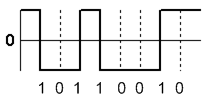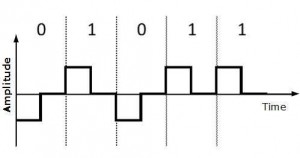Terminology
Data element: In data communications, our goal is to send data elements, like a passengers.
Signal element: the shortest unit of a digital signal, it is the carrier, like the vehicle.
The relation between data element and signal element can be 1 to 1, 1 to multiple, multiple to 1.
Data rate: the number of data elements(bits) sent in 1 second, unit is bits per second(bps).
Signal rate: number of signal elements sent in 1 second, unit is baud. Sometimes signal rate is called the pulse rate, the modulation rate or the baud rate.
The relationship between data rate and signal rate is :
S=c x N x 1/r
- S is the number of signal elements
- c is the case factor, the best , worst or average.The average is 1/2.
- N is the data rate.
- r is the previously defined factor, for a signal with L levels, r=log2L.
Just like the actual number of vehicles affects the traffic. The signal rate affects the bandwidth.
So, if we have minimum Bandwidth Bmin=c x N x 1/r. Then we can have the maximum data rate: Nmax=1/c x Bmin x r
Line coding schemes
Unipolar scheme:
The energy is concentrated
Polar schemes:
- NRZ:
Problems:
Baseline wandering is a problem for both schemes. NRZ-L: If there is a long sequence of 0s or 1s in NRZ-L, the receiver have difficulty discerning the bit value. NRZ-I: If a long sequence of 0s, we have the same problems as NRZ-L.
Synchronization: Receiver doe not know which bit has ended and the next is starting. exist in both NRZ-L and NRZ-I, but more serious in NRZ-L.
Sundden change of polarity in the system. If the polarity changes, NRZ-I does not have a problem; but NRZ-L will interpret 1s as 0s and 0s as 1s.
The synchronization problem has been solved.
There are some other problems: Sudden change of polarity problem exists, three level of voltage, more complex to create and discern.
- Biphase schemes: Manchester and Differential Manchester. See here.
Problems: need twice bandwidth as the NRZ.
- Bipolar schemes: AMI( alternate mark inversion), In this code, a binary 0 is encoded as zero volts, as in unipolar encoding, whereas a binary 1 is encoded alternately as a positive voltage or a negative voltage.Means 1st one is positive, then 2nd one is negative, then 3rd one is positive. The name arose because, in the context of a T-carrier, a binary ‘1’ is referred to as a “mark”, while a binary ‘0’ is called a “space”. This is used in long distance communication.



